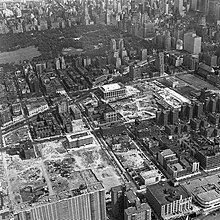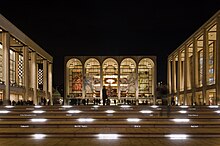San Juan Hill, Manhattan

San Juan Hill was a community in what is now the Lincoln Square neighborhood of the Upper West Side in Manhattan, New York City. Its residents were mostly African-American, Afro-Caribbean, and Puerto Rican, and comprised one of the largest African-American communities in New York before World War I. San Juan Hill was bound by 59th Street to the south, West End Avenue to the west, 65th Street to the north, and Amsterdam Avenue (part of Tenth Avenue) to the east.[1] The site is now occupied by Lincoln Center, a 16.3-acre (6.6 ha) complex dedicated to the performing arts.
Etymology[]
There are different opinions as to why the area was called San Juan Hill. Some critics say that it refers to the Spanish–American War of 1898 fought in Cuba. It is also said that it was because African-American veterans from the war lived in the area. Others say that the name was given to the area due to the constant ethnic gang fights between African-Americans and Irish-American gangs.[2]
History[]
African-Americans moved into the area around the late 19th century from Greenwich Village, where an earlier African-American community existed.[3][4] Before the construction of Lincoln Center and the subsequent destruction of San Juan Hill, jazz and art thrived in this area as its popularity began to grow. The neighborhood had a jazz club called "Jungle Cafe" nicknamed the jungle by the members of the neighborhood. This term was used by Milton Mezz Mezzrow, a white jazz clarinetist. Mezzrow was introduced to jazz while living in Harlem, where he heard recordings of James P. Johnson, the pianist from San Juan Hill in which he said "Here’s a boy from the Jungles who makes all the other piano players look sick!”[5] Moreover, this basement club was where Charleston was reputedly born and got its start. The area's musical history continues today at Jazz at Lincoln Center.[6] Historian Marcy S. Sacks writes that San Juan Hill had many tenement basement clubs ranging from dives to higher-level clubs. And that there were also poolrooms, saloons, dance halls, and bordellos.[7][page needed]
San Juan Hill had many African-American churches that, according to historian Marcy Sacks, moved into the area around the 1880s and 1890s.[7][page needed] Among these were St. Mark's Methodist Episcopal, Mt. Olivet Baptist, as well as St. Benedict the Moor Church in neighboring Hell's Kitchen.[5] The area had numerous community and fraternal organizations, such as the Grand United Order of Odd Fellows, Negro Elks, and the Colored Freemasons. This community also attracted war veterans returning from the Spanish- American War of 1898 which could have given rise to its name.[8]

Displacement[]
San Juan Hill was mostly erased due to the 20th century sweep of "urban renewal" to create Lincoln Center, displacing thousands of families, and leaving a number of people never to know the neighborhood existed. In the early 20th century African-Americans started to move from San Juan Hill to Harlem. The African-American population decreased while the Puerto Rican population grew. More Puerto Rican families started moving there in the 1950s coinciding with a massive influx of Puerto Rican migration after World War II. In the 1940s the neighborhood of San Juan Hill was designated as a slum and called "the worst slum district of New York City" by the New York City Housing Authority.
In 1947, the City of New York made San Juan Hill an area for redevelopment. Parts of San Juan Hill, from 61st to 64th Streets along Amsterdam to West End Avenues were demolished in 1947, and the Amsterdam Houses were completed in 1948. More than 1,100 families, mostly African-American and Puerto Rican, were evicted to build the Amsterdam Houses. During this time, the displacement of more than 7,000 lower-class families and 800 businesses happened, mainly being due to the price increase regarding the renewal process of clearing up the slums. Although 4,400 new housing units were intended for future residents. The rent of rooms after the urban renewal project took place would range from $40-$50 a room, which was too high for the original residents. However, few tenement houses still stand today, one exception being Phipps Houses on 63rd Street. The buildings make up the oldest affordable housing units that led to the move of the working class and quality of life that was rare for the people of color during this time. Moreover, Roseanna Weston, a resident of San Juan Hill who lived in this housing said that she remembered that before living in Phipps houses, her family lived in a run-down tenement.[8] Known as the ideal tenement, it was one of the last tenement buildings left standing after the demolition of San Juan Hill.[9]
Declaring the area of San Juan Hill a slum later became the first step in a city redevelopment project in the name of urban renewal. Robert Moses, a developer and chairmen of Committee on Slum Clearance and leader of urban renewal projects throughout most of the 1950s and 1960s, used a federal program to claim the land in the area of San Juan Hill under eminent domain. This law was Title I of the 1949 Housing Act, giving federal backing for urban renewal projects. These projects created middle-class housing while displacing lower-income families, and made room to create Lincoln Center. This post-WWII transformation of San Juan Hill neighborhood is said to have been an early example of urban gentrification.[10][9]
In the 1950s, the neighborhood was almost completely torn down and Lincoln Center was built. The land was obtained by Moses using eminent domain turned a multi-ethnic community into an elite cultural venue, unaffordable to the families he displaced. By 1955, Robert Moses struck a deal with the Met Opera to develop the neighborhood north of Columbus Circle into a home for the arts. Other organizations such as Fordham University, the New York Philharmonic, and the Juilliard School of Music soon followed suit moved their headquarters and campuses to the center.[11] The area had been the home of over 17,000 residents.[12][5][13] Construction on the development project started in 1959.[9][10][14]
Legacy[]

San Juan Hill was known as the birthplace of the Charleston and Bebop. Today, Lincoln Center is the home of the New York City Opera, New York Philharmonic, New York City Ballet, and the Metropolitan Opera.
The 1926 David Belasco musical Lulu Belle (musical) is set in part in the community. It was adapted into the 1948 film Lulu Belle (film).
Location work for the film West Side Story (1961) used parts of San Juan Hill following the condemning of the neighborhood's buildings; piles of debris from recently demolished buildings feature in many shots.[11] The same neighborhood serves as the setting for the 2021 film, with the added context of the incoming construction of Lincoln Center serving as a major plot point.[15]
Notable residents[]

Thelonious Monk, the jazz pianist, grew up in San Juan Hill, raised in the Phipps houses on West 63rd street. A portion of a street in the old San Juan Hill neighborhood was named after Thelonious Monk. After his death, Monk's family created the Thelonious Monk Foundation to help improve music education throughout the United States.[16] Jazz pianist Herbie Nichols was also born in the neighborhood, and became a friend of Monk later in life.[17]: 156, 174
Pianist James P. Johnson, one of the pioneers of the stride style of piano playing family moved to San Juan Hill in 1908. Johnson composed the Roaring Twenties popular song "Charleston".
Notable historian Arturo Schomburg, of the Schomburg Center for Research in Black Culture, lived in San Juan Hill with his first wife and 3 sons.
Barbara Hillary the first African-American woman to reach the North Pole, and then the first African-American woman to reach the South Pole, and therein the first African-American woman to have reached both poles, was born in the neighborhood.[18]
References[]
- ^ "Photographic image" (JPG). Images8.webydo.com. Retrieved January 30, 2020.
- ^ "Vintage Photos: The Lost San Juan Hill, Lincoln Center and a West Side Story". Untappedcities.com. 19 March 2014.
- ^ "Lincoln Center: From Dutch enclave and notorious San Juan Hill to a thriving cultural center - 6sqft". 6sqft.com.
- ^ "Manhattan's Long Gone San Juan Hill - Destinations". Noirguides.com.
- ^ a b c "A west side story". Nypress.com. 2016-11-07. Retrieved October 16, 2019.
- ^ Geberer, Raanan. "NY Times -Weekend Explorer". YouTube.
- ^ a b Sacks, M.S. (2013). Before Harlem: The Black Experience in New York City Before World War I. Politics and Culture in Modern America. University of Pennsylvania Press, Incorporated. ISBN 978-0-8122-0335-6. Retrieved October 16, 2019.
- ^ a b "Remembering Neighborhood Voices Part 1". Archives of NYC Department of Records and Information Services.
- ^ a b c Williams, Keith (2017-12-21). "How Lincoln Center Was Built (It Wasn't Pretty)". The New York Times. ISSN 0362-4331. Retrieved 2019-10-16.
- ^ a b Sara (25 April 2011). "American Civilization: From the Slum to the Center: Robert Moses and the Creation of Lincoln Center". Sghistory.blogspot.com.
- ^ a b "Lincoln Center: Making Music atop San Juan Hill". Keithyorkcity.wordpress/com. 2012-10-10. Retrieved 2019-05-10.
- ^ Strausbaugh, John (2008-02-01). "Weekend Explorer - Lincoln Center Area". The New York Times. ISSN 0362-4331. Retrieved 2019-10-16.
- ^ "Manhattan's long-gone San Juan Hill". Ephemeralnewyork.wordpress.com. 15 October 2008.
- ^ "San Juan hill Lincoln Center west side story". LifeDocLifetime.com.
- ^ Acevedo, Nicole. "Spielberg ditches the brownface in a 'West Side Story' remake that centers Puerto Ricans". NBC. Retrieved 11 December 2021.
- ^ Gray, Christopher (2003-11-23). "Streetscapes/Henry Phipps and Phipps Houses; Millionaire's Effort to Improve Housing for the Poor". The New York Times. ISSN 0362-4331. Retrieved 2019-10-16.
- ^ Spellman, A.B. (1985). Four Lives in the Bebop Business. New York: Limelight Editions. ISBN 0879100427.
- ^ https://www.nbcnewyork.com/news/local/barbara-hillary-1st-black-woman-at-north-south-poles-dies/2221012/
External links[]
- History of Manhattan
- African-American history in New York City
- Former New York City neighborhoods
- Neighborhoods in Manhattan

